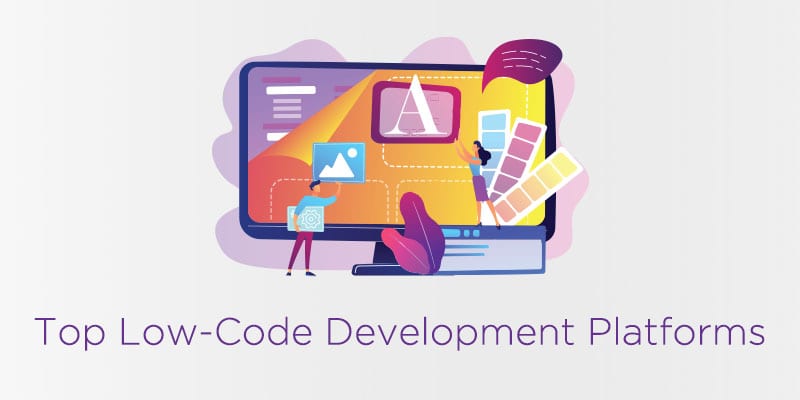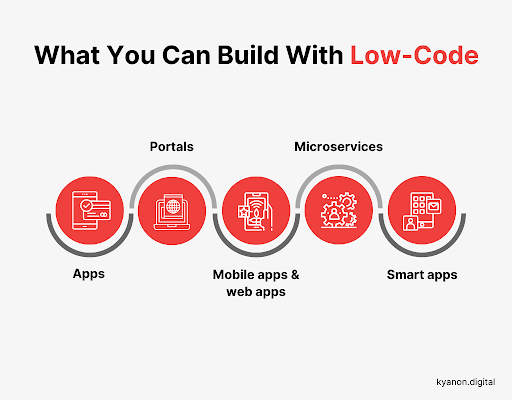Excellent Suggestions To Deciding On Low-Code Platform Recommendations
Excellent Suggestions To Deciding On Low-Code Platform Recommendations
Blog Article
Benefits Of Low-Code Application Development For Developers Who Are Not Developers.
Due to several factors, low-code application development is more accessible to non-developers. They are commonly referred to as "citizens developers."
Drag-and-Drop Builders: Low-code systems offer drag-and–drop interfaces which enable non-developers, without the requirement to write code to create visually appealing applications. The process of developing applications is now more accessible for people with no technical background.
WYSIWYG: WYSIWYG editors are "What you See is What you get" editors that allow users to create workflows and interfaces that are similar to the final product. It makes it much simpler to use and understand.
Simplified Design of Logic and Workflow
Visual Workflow Modeling: Users are able to design business procedures, application logic, and flowcharts through diagrams as well as visually-designed flowcharts. These methods are much more intuitive than traditional coding methods.
Low-code platforms are often equipped with pre-built logic elements (e.g. the conditional loops, statements) which eliminate the need for complicated programming.
Reusable templates and components:
Library of Pre-built Templates: Numerous low-code platforms have templates for common application types, enabling non-developers to start with a solid foundation to modify as they need to.
Reusable modules and widgets: The process of creating websites is made easier through the use of reusable components and modules. This reduces the necessity for a deep technical understanding.
Guided Development and Tutorials:
Step-by-Step Guides: Platforms typically provide a development path with guidance, online tutorials, or on-screen instructions to assist users who aren't developers to create applications.
Interactive Tutorials. Interactive, hands on tutorials enable users to learn through doing.
Integration with tools already in use:
Easy integration Low-code platforms are designed to easily integrate with existing business systems and tools (e.g. ERP, CRM) making it possible for non-developers to develop applications that fit into their workflows.
APIs/Connectors: The APIs/Connectors built-in allow non-developers to connect their applications to external services.
Collaboration Features:
Team Collaboration: Features, such as real-time collaboration and shared workspaces, help professionals and non-developers to work together efficiently.
Role-Based Access Control: Non-developers can be assigned specific roles, with the appropriate access levels, which ensures they can contribute to the development process without compromising security and functionality.
Automated Testing and Debugging
Low-code platforms are usually equipped with testing and debugging software that can automatize these procedures. This makes it much easier for non developers to verify their applications work correctly.
Error-highlighting: The platform highlights issues and suggests fixes for non-developers.
The general rule is that low-code app development has the ability to open up development to a wider audience. This is a major benefit for those who aren't developers. Low-code platforms are easy to use, visual tools, guided experiences and enable business users actively participate in creating updates, maintaining and enhancing applications. Check out the recommended top article on Low-code Platform for application development for site info including develop web application, rapid applications, rapid app development, build a docker container, ms azure sql, cross platform app development, cross platform app development, cloud software applications, develop cross platform mobile app, build a docker container and more.
Benefits Low-Code Applications In Safety And Governance
Low-code development has several benefits in terms of security and governance. They are essential for ensuring applications are secure, reliable and properly managed throughout their lifecycle. Here are a few key advantages.
Unified management console: Low code platforms typically provide a centralized administration console where administrators are able to manage all the applications and ensure consistent governance within the organization.
Role-Based Access Control RBAC : These platforms usually include robust roles-based access controls, which permit administrators to define and enforce rules. This permits only authorized users to alter or access specific parts of a program.
Compliance and Regulatory Application:
Many low-code platforms include built-in compliance functions. They are developed in accordance with industry standards, regulations and laws (e.g. HIPAA, GDPR). They provide templates and tools to ensure that the applications are compliant with these regulations.
Audit trails and logs Audit trails that are comprehensive and logging can be connected. This allows organizations to monitor and track changes and access, and also ensure conformity with internal rules as well as external regulations.
Increased Security Measures
Data Encryption: Low-code platforms typically provide built-in encryption for data that is in storage and in transit, ensuring that data sensitive information is secured.
Security Certificates: Many low-code companies have a security certificate (e.g. ISO 27001 and SOC 2) which demonstrate that they are adhering to strict security guidelines. They provide an additional security level to their clients.
Automated security Updates
Regular Patching and Updating Lowcode platforms typically handle regular updates to security. These patches guard users from the most recent threats without requiring developer intervention.
Security Monitoring: Tools to conduct continuous monitoring of security are provided. They send immediate alerts and insight into security issues that might arise.
Data Governance
Data Access Policies: These platforms permit companies to establish and enforce policies regarding data access, ensuring that data is only accessible only to those who have been granted access and properly used.
Data Masking & Anonymization: Tools built in for data masking & anonymization ensure the security of sensitive information, especially in testing environments and development environments.
Consistent Lifecycle Application Management:
Development and deployment pipelines: Lowcode platforms typically provide integrated development-and-deployment pipelines with security checks. They ensure security throughout the application's lifecycle.
Version Control. Integrated version management helps track and reverse any changes made to the application, making sure that its integrity is preserved.
User Authentication:
Single Sign-On: The support for SSO as well as other sophisticated authentication methods eases managing users and increases security.
Multi-Factor Authentication (MFA) Numerous platforms provide built-in support to multi-factor authentication, adding an additional layer of security for accessing applications.
Policy Enforcement Monitoring and Compliance:
Low-code platforms often come with templates for policies that are pre-defined to help organizations implement governance and cybersecurity policies quickly.
Tools for Monitoring Compliance: These tools track and report continuously on compliance status. They help to find problems and address these issues in a proactive fashion.
Integration into Existing Security Infrastructure
Seamless Intergration: Low code platforms are designed to facilitate seamless integration with existing security tools and equipment, including Identity Management Systems, SIEM Solutions (Security Information and Event Management), and Firewalls.
API Security API Security: Built-in API security features ensure that integrations with external systems are secure, securing the integrity of data as well as ensuring that applications remain secure.
Training and best practices:
Best practices for guideline: Several platforms have guidelines and suggested methods for developing secure applications. They assist non-developers in meeting security requirements.
Some lowcode providers offer tools and security education for users to help them understand how to build and maintain a secure application.
Overall the governance and security advantages of developing applications using low-code ensure that applications are built and managed in a secure, compliant, and controlled manner. These platforms provide all the tools and frameworks necessary to safeguard sensitive information and enforce policies while maintaining the regulatory compliance. Have a look at the most popular wavemaker.com coding for site examples including jdbc server, develop mobile application, build with docker, app dev platform, paas service, cloud software applications, no code platforms, cross platform mobile dev, rad development, cross platform mobile app development and more.
Benefits Of Low-Code Application Development In Terms Of Community Support And Vendor Support
Low-code platforms have significant advantages in terms of community and vendor support, both of which are crucial to the success in the implementation, maintenance and improvement of applications. Vendor Support
Comprehensive Technical Support:
Support Teams: Many platforms that make use of low-code offer special support teams that assist with technical problems, troubleshooting and guidance.
24/7 Support Certain vendors are accessible around the clock This is useful for businesses operating in multiple time zones.
Training and Onboarding
Structured training programs: Vendors offer structured courses like webinars or certification courses. This allows users to quickly master the platform.
Personalized Onboarding: Many vendors offer personalized onboarding services to help new customers to use the platform in a way that is effective and customize it to meet their requirements.
Regular updates and enhancements
Continuous Improvements: Low-code providers regularly release updates that include improvements in performance as well as new features and security patches, in order to keep their platform current.
Feedback Integration: Vendors integrate feedback from users into their design cycles to ensure the platform is evolving to meet the evolving needs of its users.
Comprehensive Documentation:
The Documentation In Detail Users can get answers to their questions by referring to a detailed and organized manual that covers all aspects of the program beginning with its fundamental functionality to more advanced modifications.
API References API documentation can help developers customize and integrate applications with the Low-Code platform.
Professional and Consulting Services
Expert Consultation: Vendors frequently provide consulting services to help in the process of strategic planning as well as design of architecture and complex implementations, ensuring that users are able to use the platform to its fullest potential.
Custom Development Services Certain companies offer customized development services to create specific integrations and features that are not available as standard.
Community Support
Active User Community:
Forums and Discussion Boards Many low-code platforms have vibrant online communities that allow users to discuss issues, ask questions, and share solutions, and collaborate on the best practices.
User Groups & Meetups User Groups and Meetups: Local or virtual group and meetings are a great opportunity to network, learn and sharing experiences.
Collaboration and sharing of knowledge:
Community-Contributed Resources: Users often share templates, modules, and extensions that they have developed, which can be reused or adapted by others, accelerating development and innovation.
Crowdsourced Solutions: The collective knowledge and experience of a community may prove to be a useful tool in troubleshooting and finding creative solutions.
Development and learning:
Community-Led Learning: Several communities host workshops, training sessions and webinars that are often led by users with experience who can share their knowledge and advanced techniques.
Tutorials and online courses Community members frequently develop and publish online courses, tutorials and guides on how-to, improving the education resources available to all users.
Feedback and Influence:
Forums for Product Feedback: These forums often provide feedback to the vendor that can affect the development of new features or improvements.
Beta Testing Programs - Active members of the community might be eligible to participate in the beta testing program. They will get an early look at new features, and an opportunity to shape the future of the platform.
Recognition and Encouragement
A lot of companies offer community recognition programs for community recognition. These programs recognize active members of the community and also include MVP programs.
Peer Support. Community members provide peer support. They offer their expertise with new users and offer guidance. This creates an atmosphere that is supportive and collaborative.
In general, the combination of robust vendor support, and an active and engaged community creates a broad ecosystem of support for low-code development. The combination of strong vendor support and a vibrant and engaged community creates an entire support network for development of low-code applications.